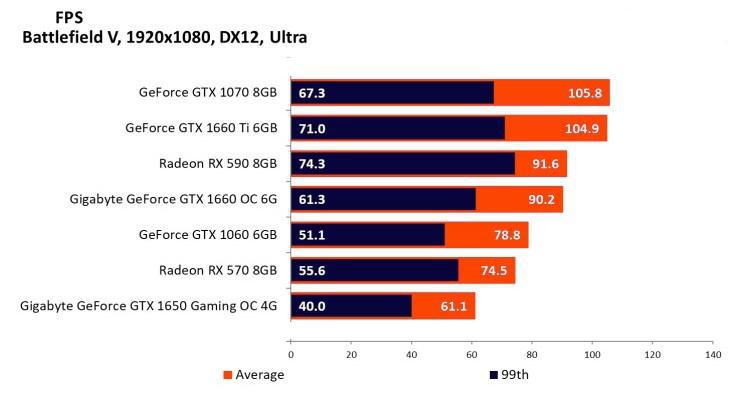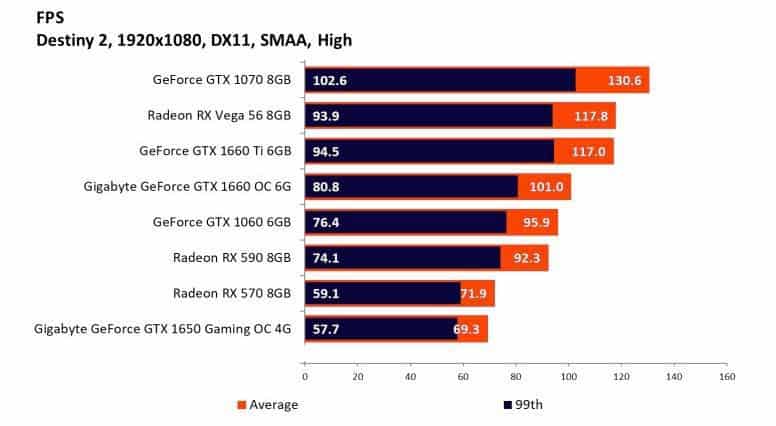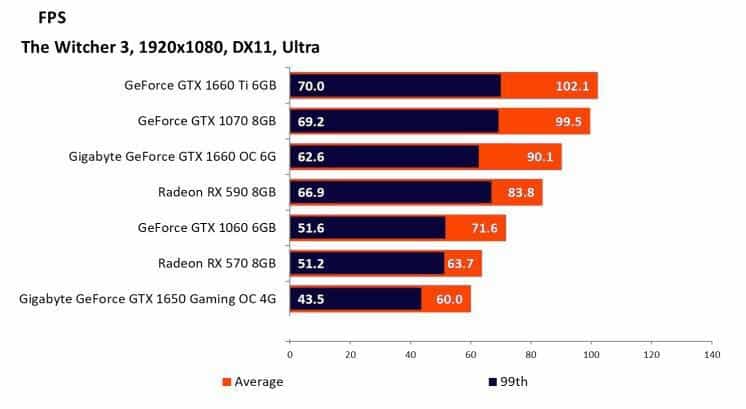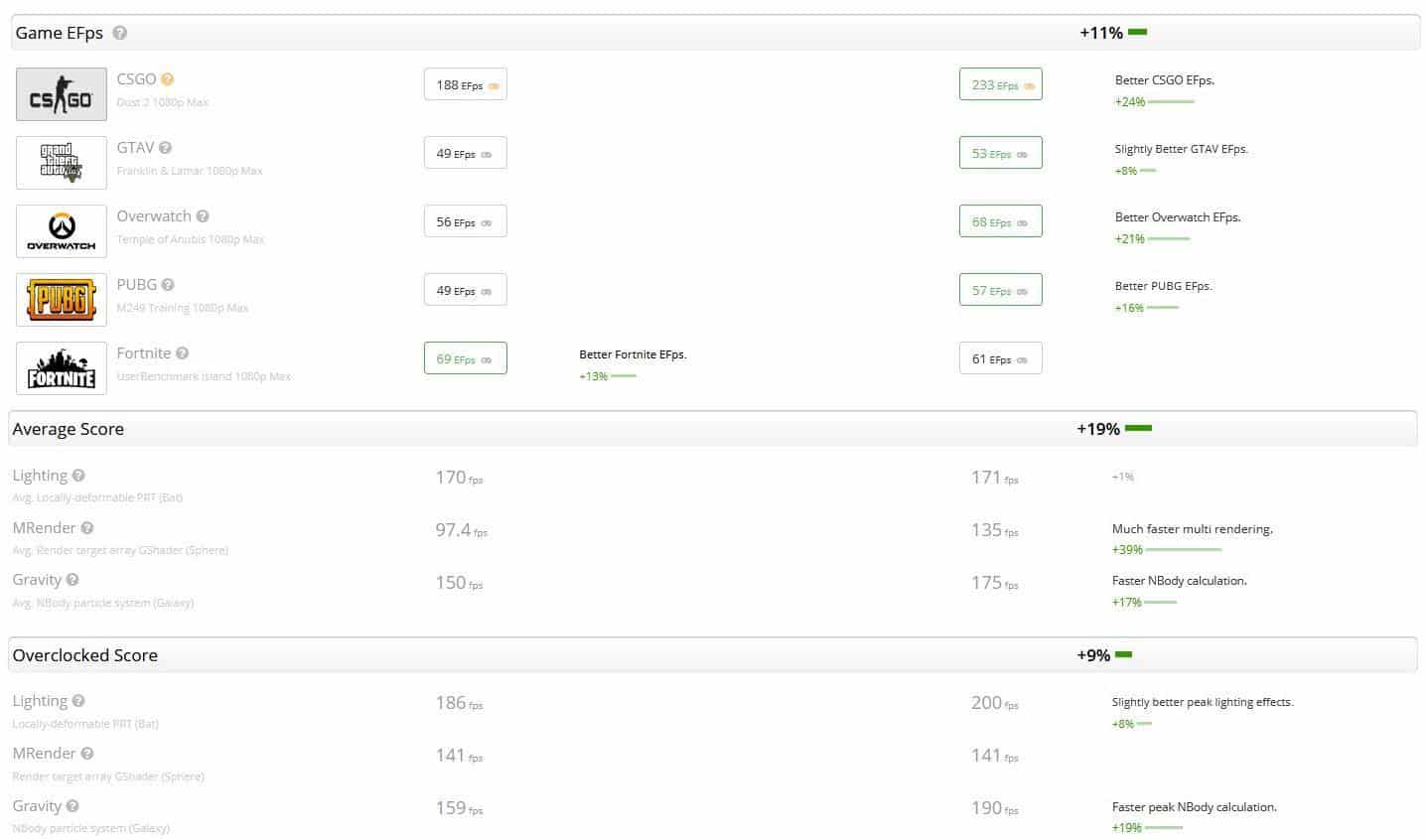Hardware
NVIDIA GeForce GTX 1650 Review
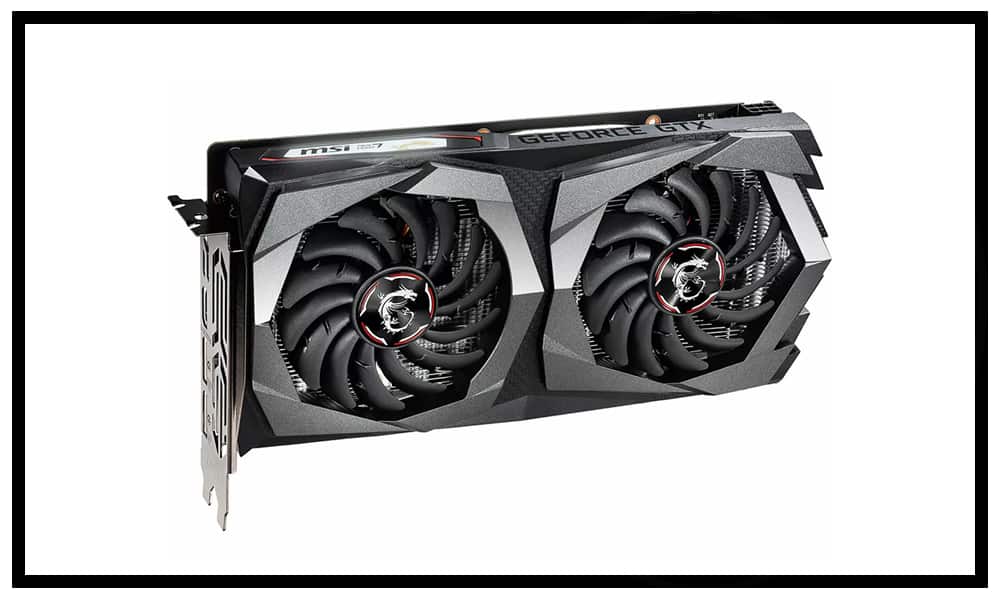
Gigabyte GeForce GTX 1650 – Is it the best budget-friendly GPU on the market?
Introduction, Features and Technical Specifications
The GeForce GTX 1650 appeared on the market in April 2019 and it has seen various reactions from users so far. With a TU117 architecture, the GeForce GTX 1650 has 4GB of GDDR5, clocked at 8GT/s. With four active memory controllers on a 128-bit bus, we see more bandwidth than what the GTX 1050 Ti delivered.
Today we will be taking a look at the NVIDIA GeForce GTX 1650, more exactly at the one offered by Gigabyte. The NVIDIA GeForce GTX 1650 is focusing on good cooling capabilities, which are boosted by Gigabyte’s WINDFORCE cooling system. The video card also aims to deliver great performance as well.
We will run some tests and see what Gigabyte has to offer in terms of performance and if it is a good offer for its price tag.
In short, the features presented by NVidia are:
- Powered by GeForce® GTX 1650
- NVIDIA Turing™ architecture and GeForce Experience™
- Integrated with 4GB GDDR5 128-bit memory interface
- WINDFORCE 2X Cooling System with alternate spinning fans
- 80 mm unique blade fan
Core Clock
- 1710 MHz (Reference card is 1665 MHz)
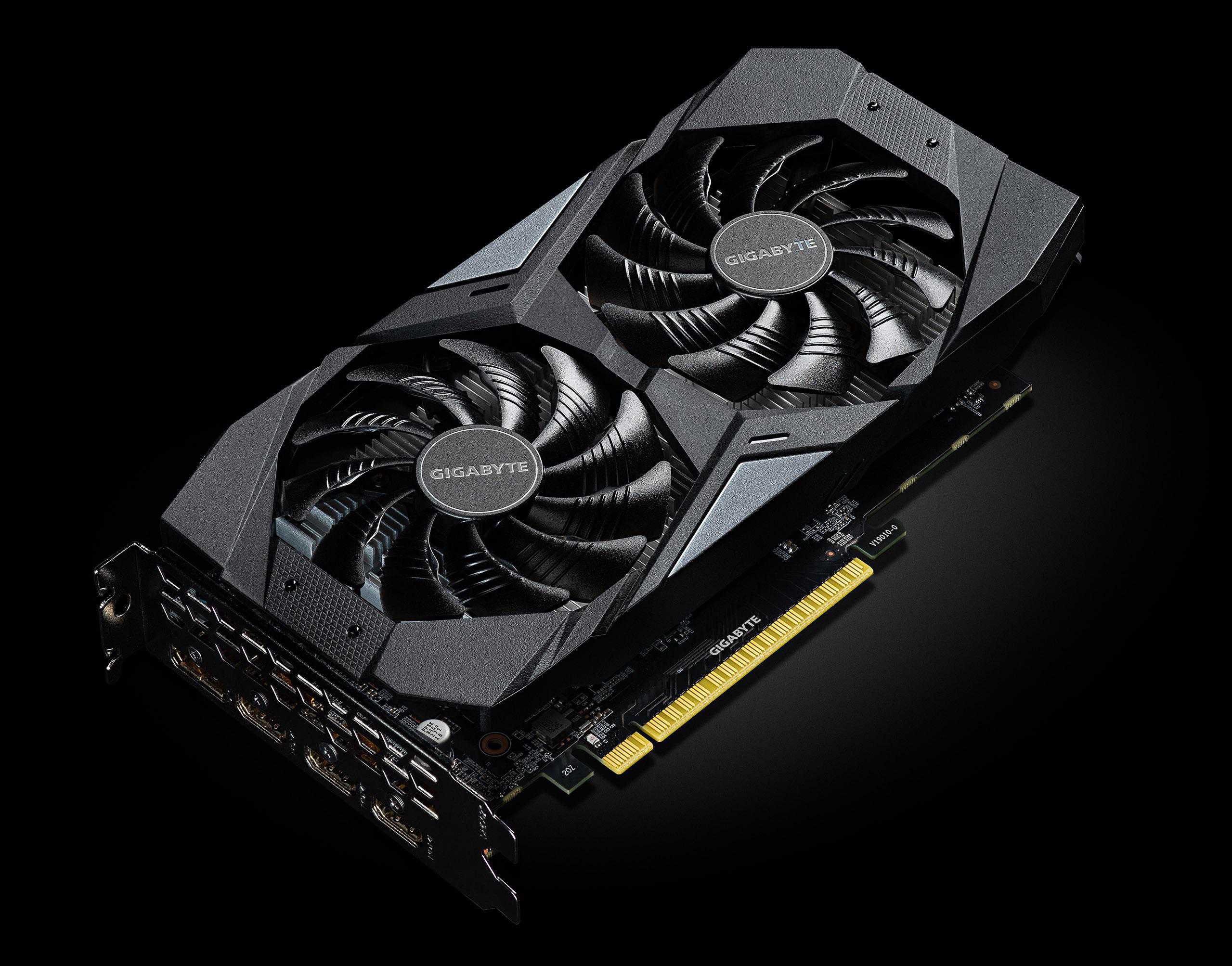
Let’s check out more info regarding features and specs, as well as the proprietary features from Gigabyte.
Built with NVIDIA Turing™ architecture, the GeForce GTX 1650 is marketed by NVIDIA as being twice as performant as the GeForce GTX 950 and up to 70% faster than the GTX 1050. Here are NVIDIA’s details on the Turing Shaders.
TURING SHADERS
Featuring concurrent execution of floating point and integer operations, adaptive shading technology, and a new unified memory architecture with twice the cache of its predecessor, Turing shaders enable awesome performance increases on today’s games. Get 1.4X power efficiency over previous generation for a faster, cooler and quieter gaming experience that take advantage of Turing’s advanced graphics features.
COOLING SYSTEM
Gigabyte’s proprietary cooling system has been used on plenty of GPU models, including the GeForce GTX 1650. Here are all the details the brand has on the Windforce 2X Cooling system used on the GTX 1650.
WINDFORCE 2X COOLING SYSTEM
WINDFORCE 2X cooling system features 2x 80mm unique blade fans, alternate spinning fan, and 3D active fan, together delivering an effective heat dissipation.
ALTERNATE SPINNING
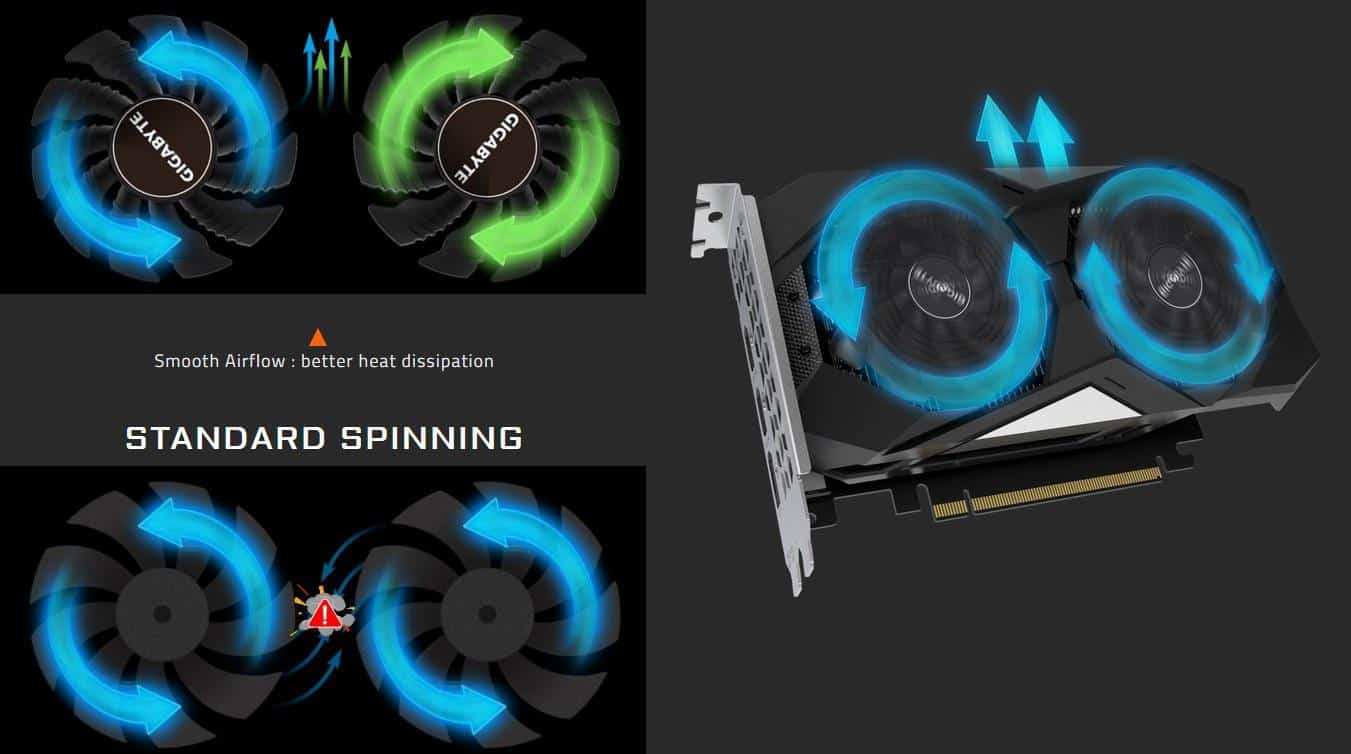
The GIGABYTE “Alternate Spinning” is the only solution that can solve the turbulent airflow of adjacent fans. Since the adjacent fans rotate in the same direction, the airflow direction is opposite between the fans, which will cause turbulent airflow and reduce heat dissipation efficiency. GIGABYTE turns the adjacent fans in the opposite direction, so that the airflow direction between the two fans is the same, reducing the turbulence and enhancing the airflow pressure.
UNIQUE BLADE FAN
The airflow is spilt by the triangular fan edge, and guided smoothly through the 3D stripe curve on the fan surface, effectively enhancing the airflow.

3D ACTIVE FAN
The 3D Active Fan provides semi-passive cooling, and the fans will remain off when the GPU is in a low load or low power game. It allows gamers to enjoy gameplay in complete silence when the system is running light or idle.
Other essential features included by Gigabyte in the GeForce GTX 1650 are the following:

Ultra Cooling
Lower RDS(on) MOSFETs are specially designed to produce lower switching resistance for faster electric current charging and discharging at extremely low temperature.
Low Power Loss
Metal Choke hold energy much longer than common iron-core chokes at high frequency, thus effectively reduce core energy loss and EMI interference.
Longer Life
Lower ESR Solid Capacitors ensure better electronic conductivity for excellent system performance and longer lifespan.
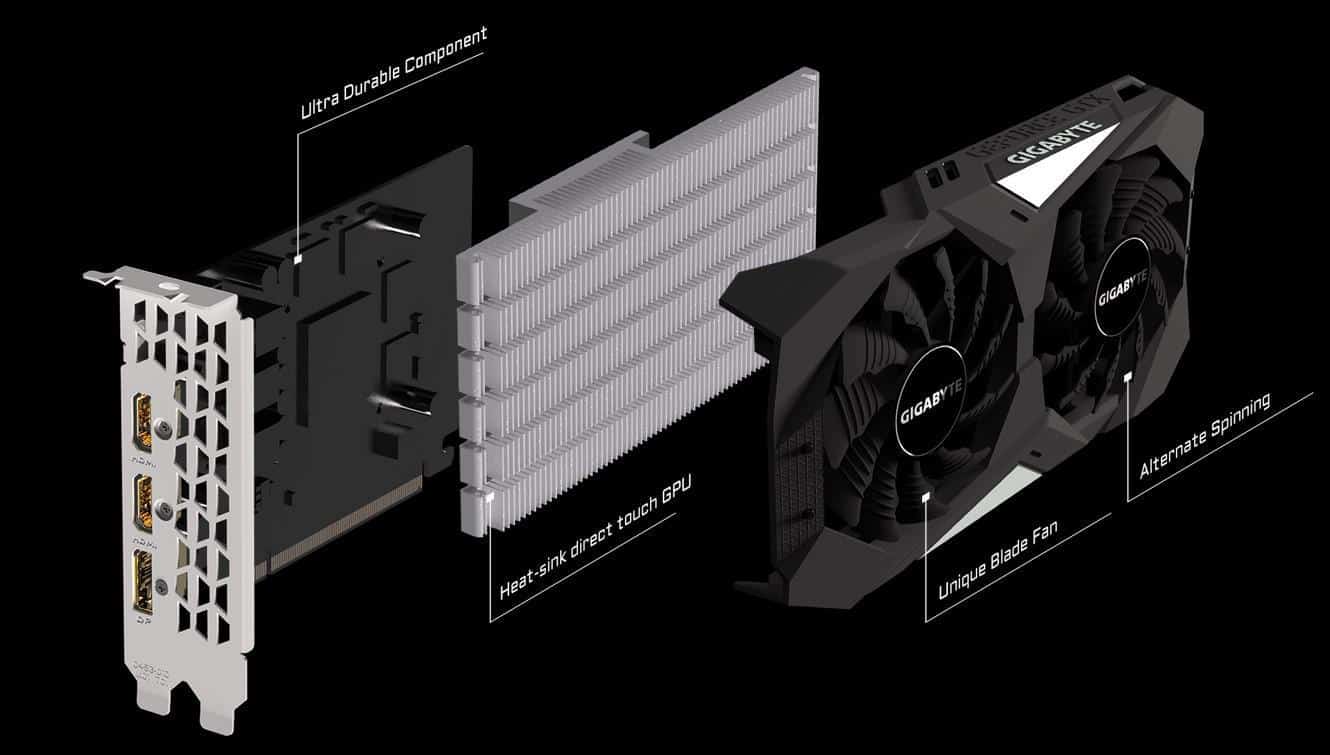
As for the official technical specs, here is what the GTX 1650 offers.
Gigabyte GeForce GTX 1650 Gaming OC: Technical Specifications
- Graphics Processing – GeForce® GTX 1650
- Core Clock – 1710 MHz (Reference Card: 1665 MHz)
- CUDA® Cores – 896
- Memory Clock – 8002 MHz
- Memory Size – 4 GB
- Memory Type – GDDR5
- Memory Bus – 128 bit
- Memory Bandwidth (GB/sec) – 128 GB/s
- Card Bus – PCI-E 3.0 x 16
- Digital max resolution – 7680×4320@60Hz
- Multi-view – 3
- Card size – L=191 W=112 H=36 mm
- PCB Form – ATX
- DirectX – 12
- OpenGL – 4.6
- Recommended PSU – 300W
- Power Connectors – N/A
- Output – DisplayPort 1.4 *1, HDMI 2.0b *2
- SLI Support – No
- Accessories – Quick guide, Driver CD
Next, let us take a look at the NVIDIA software and the AORUS Engine.
Gigabyte GeForce GTX 1650 Gaming OC: NVIDIA Features
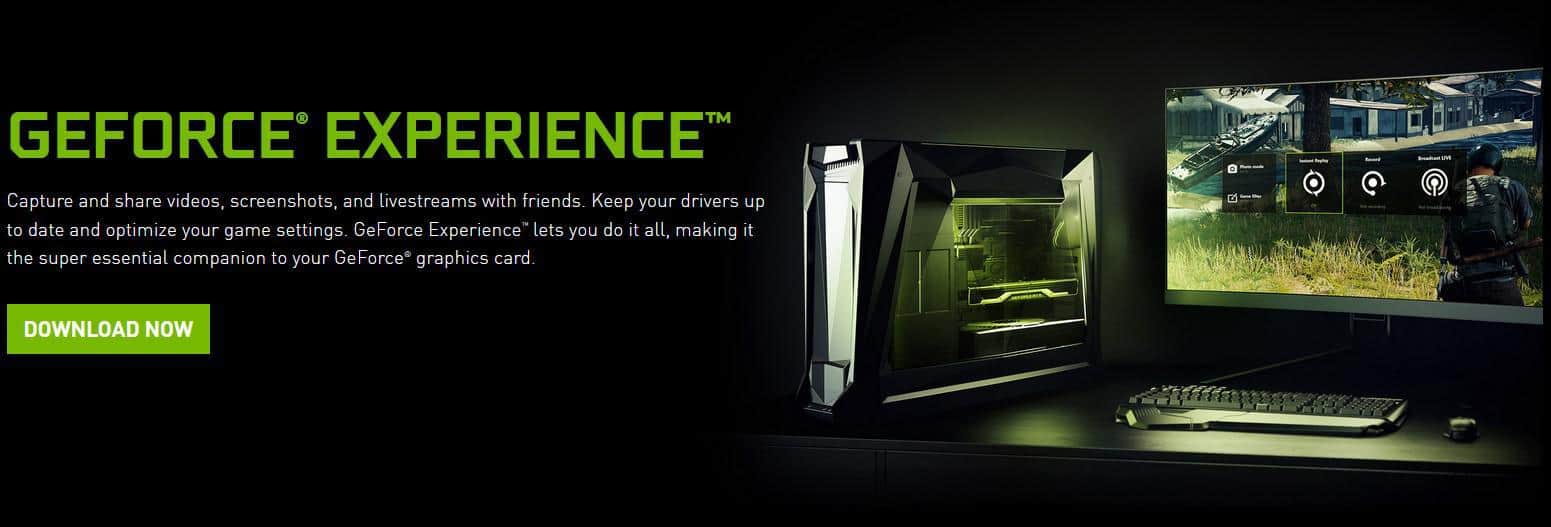
The most essential feature we have in the GeForce GPUs is GeForce Experience. As all NVIDIA GeForce GPUs, the GTX 1650 comes with GeForce Experience, the software that lets you capture videos, screenshots, but also share livestreams and more. The possibilities are endless, as GeForce Experience lets users broadcast their gameplay without disrupting gameplay. Gamers can share their livestream to YouTube and Facebook using the GeForce Experience technology called NVIDIA ShadowPlay.
Aside from livestreaming, users can optimize their game settings and personalize each option according to the game they are playing. For instance, there is a handy option that will automatically adjust graphics settings based not only on the PC’s GPU, but also the CPU and display.
NVIDIA Freestyle game filters are also available for those that want to add a fancy filter to their footage.

One more handy feature for those looking to immortalize shots from the game and transform them into professional-grade photographs is through NVidia Ansel. User can freeze the game, capture and reposition the camera for that perfect shot.
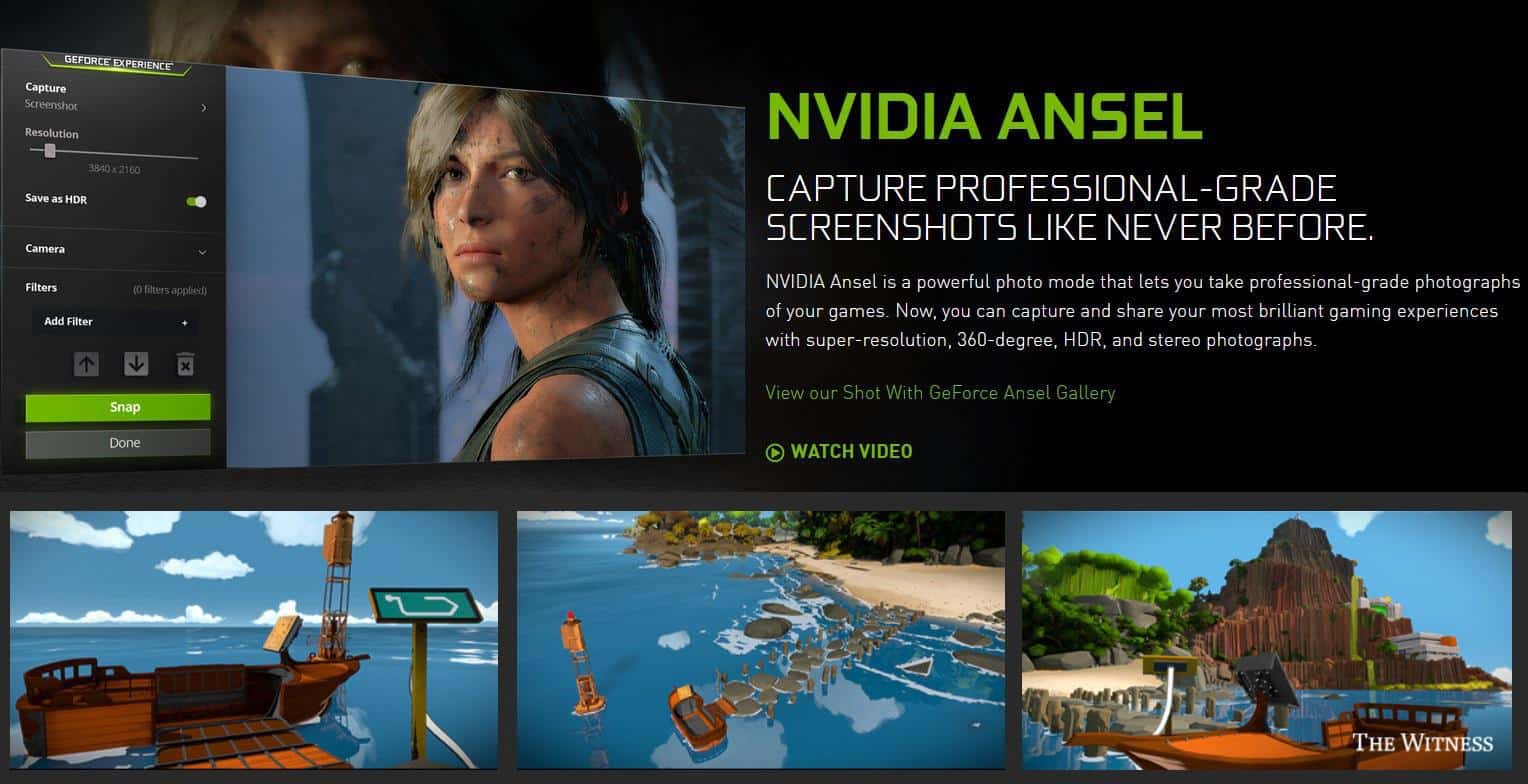
Finally, NVidia also offers Studio Drivers for the creatives through the NVidia Studio feature. The feature allows users to model and render 3D objects, edit videos, photographs and design anything at fast speeds.
Onto packaging and unboxing, we will take a closer look at the GPU.
Gigabyte GeForce GTX 1650 Gaming OC: Packaging & Unboxing
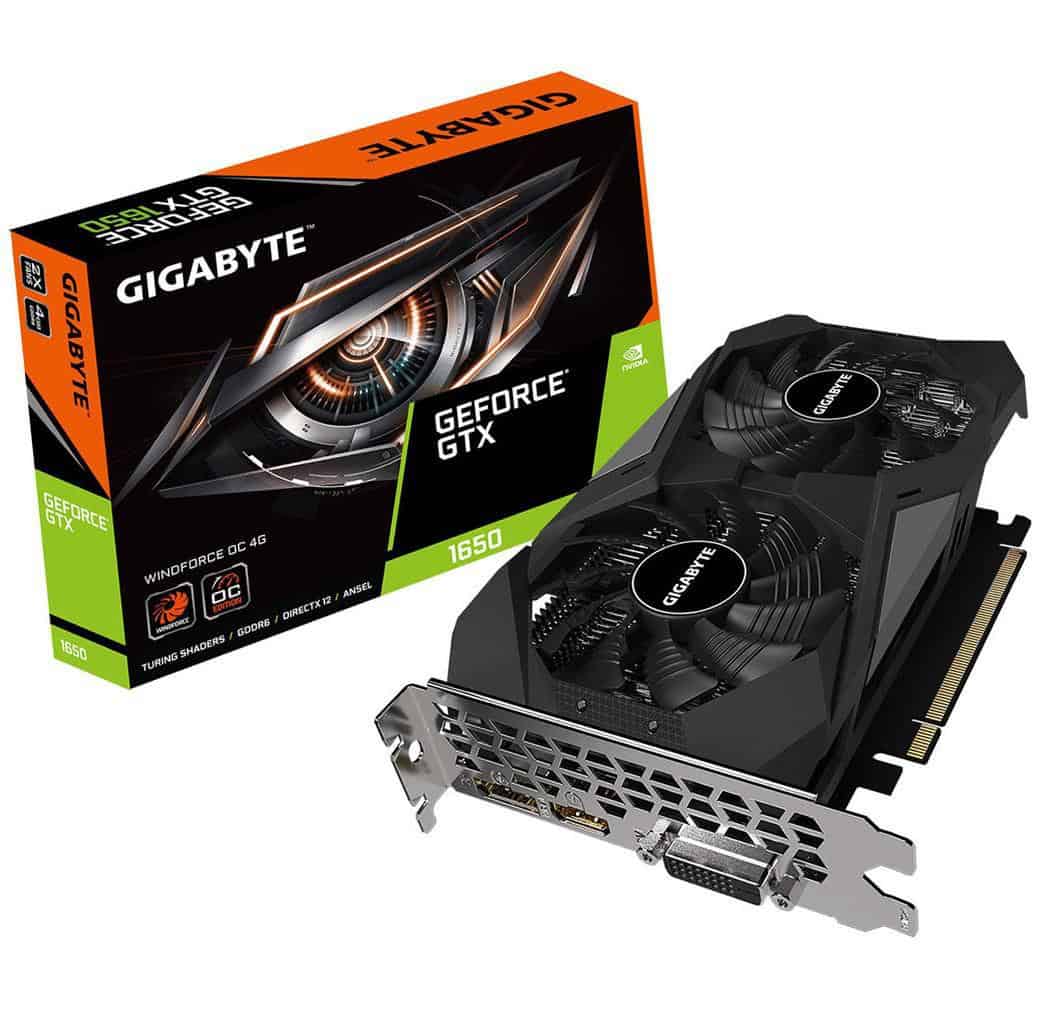
The GTX 1650 OC 4G comes into a sturdy box, easy to open and featuring a cool design. The front of the box contains the essential NVidia and Gigabyte features, such as the WINDFORCE cooling, Turing Shaders, ANSEL and of course, the 1650 series written at the bottom.
The back of the box contains more details about the WINDFORCE cooling system and the Ultra durable graphics components used for the GTX 1650. All of the essential details that are on the NVidia and Gigabyte websites are written on the back of the box, including the minimum system requirements and several warnings.
The moment we have all been waiting for: taking the GPU out of the box! Let’s take a closer look at the GPU, from all angles.
Gigabyte GeForce GTX 1650 Gaming OC: A Closer Look
The Gigabyte GTX 1650 Gaming OC looks great, we can all agree with this fact. The two fans certainly make for a very good first impression. The WINDFORCE 2x cooling system refers to the fans on the GPU. As marketed, the fans spin in opposite directions from one another, a design that should help to better dissipate heat away from the aluminum heat sink.
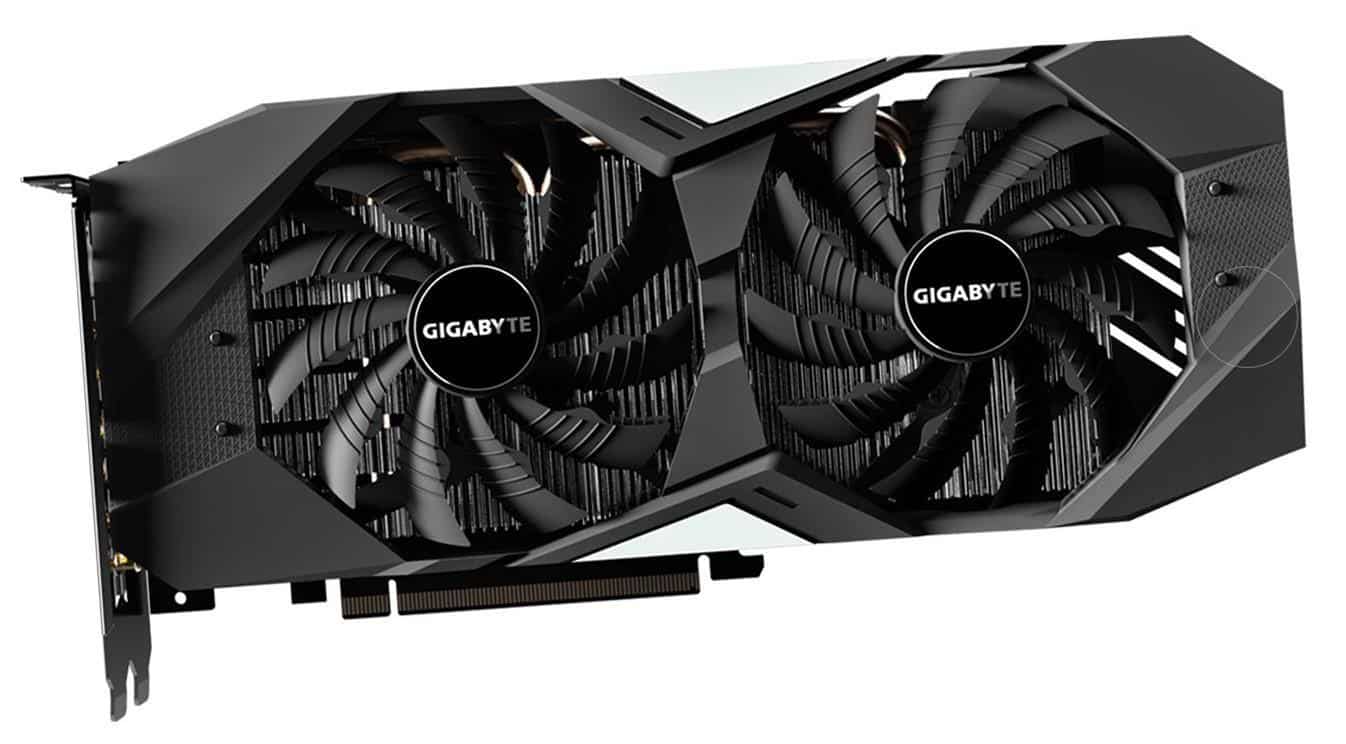
The two flattened composite copper heat pipes also allow to effectively spread the heat to the extended parts of the heatsink. The pipes run through the center, right over TU117, bending to the right and left and dissipating the heat through the aluminum fins. The entire cooling system should be able to keep the entire card cool.
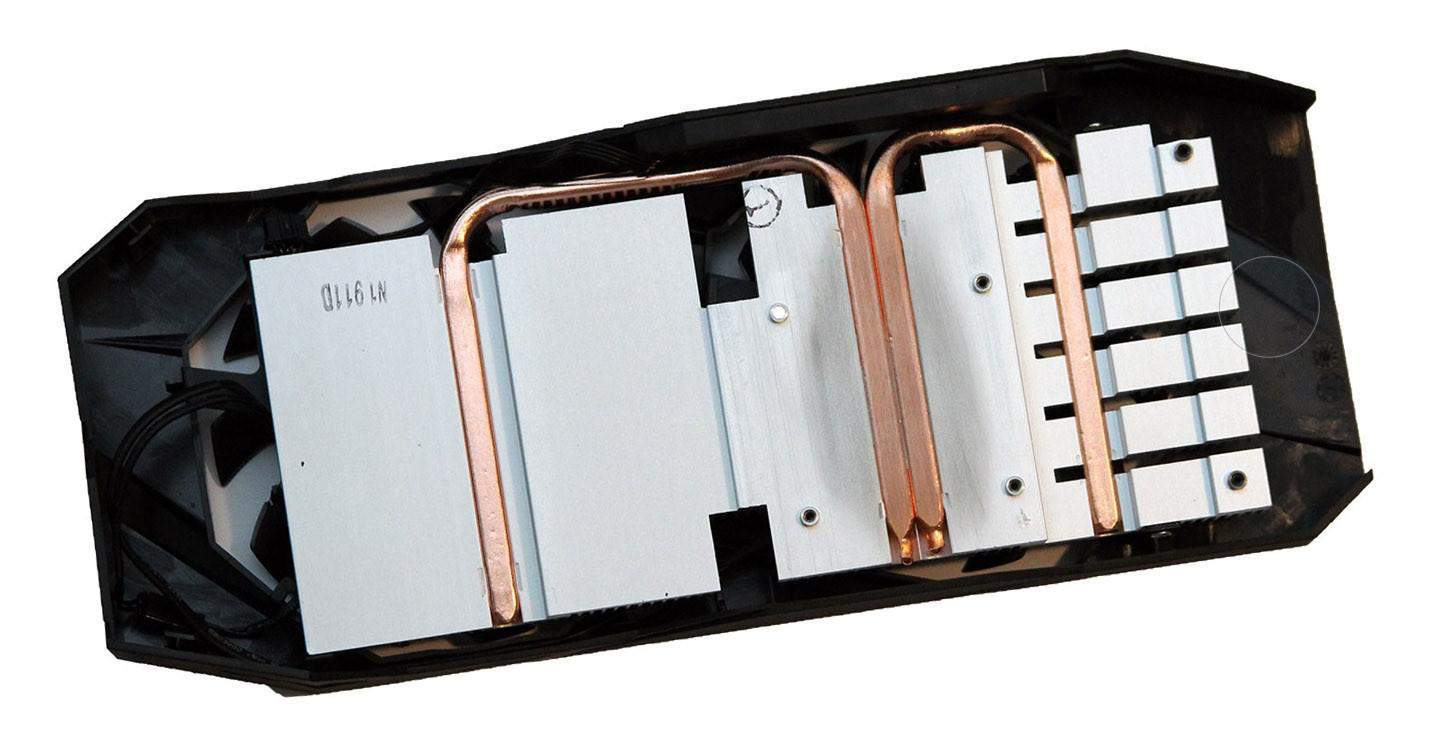
What the Gigabyte GTX 1650 lacks is a metallic back plate. The card only has a protection back plate, but since the video card is aimed at budget gamers, it is what we already expected. However, if it featured a metallic back plate, it would have slightly lowered the temperatures. This is why it’s not much of a big deal if the video card comes with a plastic protection plate instead of a metallic back plate.
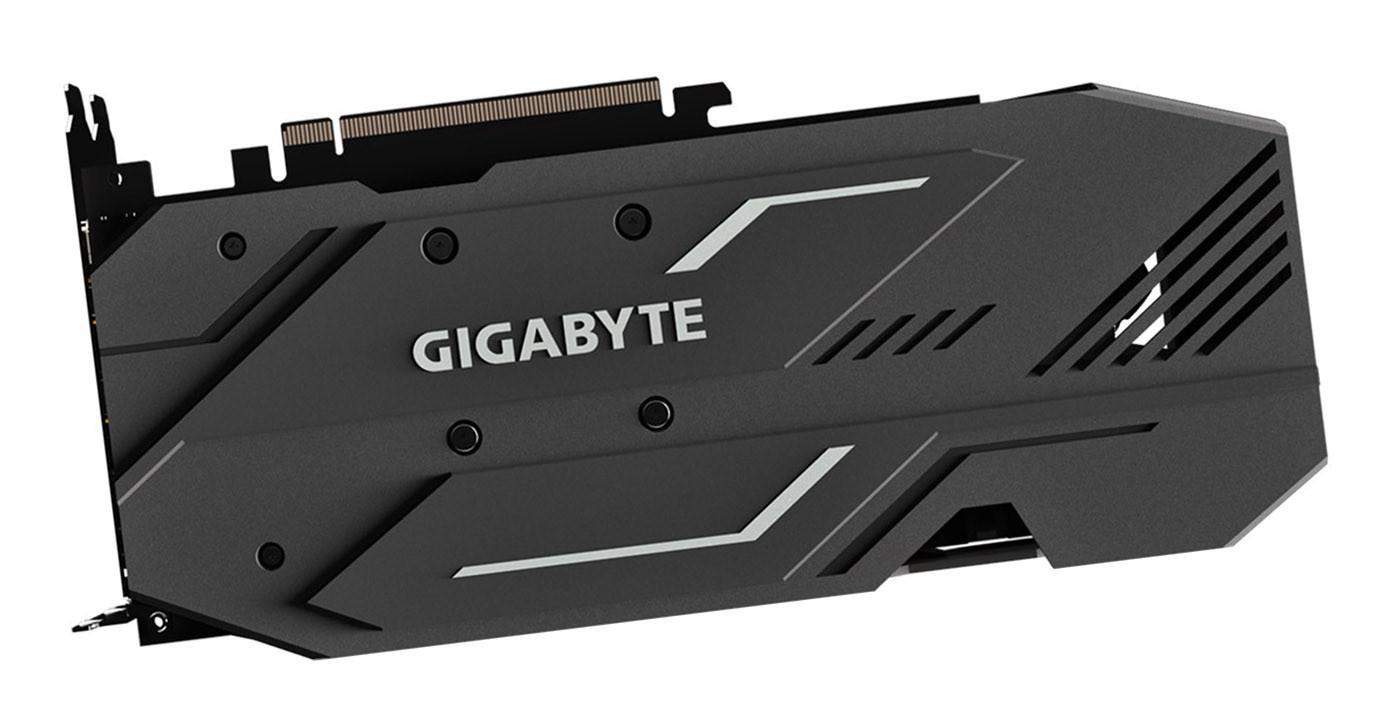
The back plate looks beautiful, complementing the design on the front, complete with the Gigabyte logo and some small gaps to let heat out.
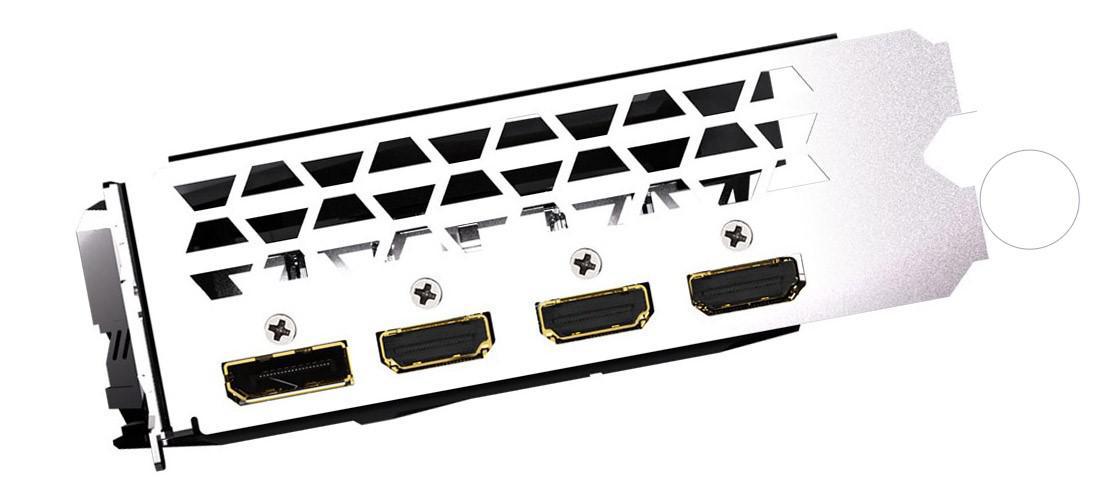
The GTX 1650 once again highlights that it is not a high-end model through its HDMI port, which is a must-have for gamers that use 1080p monitors. There are three HDMI ports and only one Display port. The four ports leave enough room for ventilation here, where the vertical fins help guide warm air down toward the main board and up against the fan shroud.
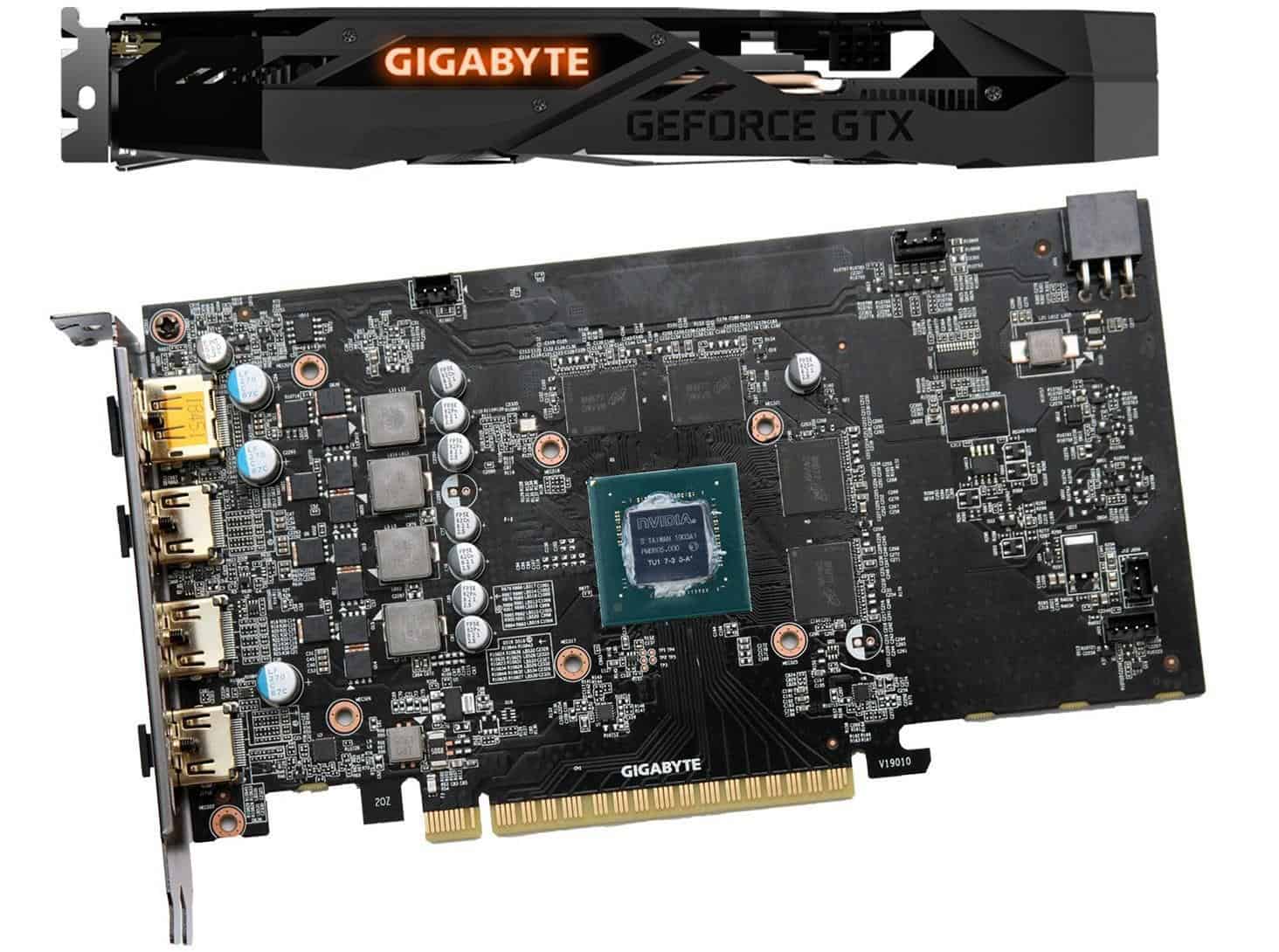
Gigabyte’s PCB is around 20 cm long, but with the fan shroud and back plate, it reaches a length of around 26.5cm. The height of the GeForce GTX 1650 Gaming OC 4G is around 12 cm from the bottom of the PCI Express slot to the top edge.
TU117 can be found in the center of the PCB, flanked by four Micron MT51J256M32HF-80:B memory modules. In contrast, the GeForce GTX 1660 uses six modules.
In terms of power consumption, the 6-pin connector is proof this GPU will not eat too much power. Gigabyte states on its official website that a 300W power supply will be capable to power an entire system, along with the GTX 1650. We will talk later in our review about the power consumption when in idle and when a game runs at high settings.
Another interesting highlight is that the top of the video card (pictured in the above photo, to the left of the 6-pin connector) will light up in RGB colors that you can control through the RGB Fusion 2.0 software. So, if you are on the RGB train, this budget-friendly GPU has got you covered!
Gigabyte GeForce GTX 1650 Gaming OC: System Configuration & Software
- CPU: Intel Core i7-7700K
- GPU: GeForce GTX 1660 Gaming OC 4G
- Motherboard: MSI Z170 Gaming M7
- RAM: G. Skill 16GB (F4-3000C15Q)
- SSD: Crucial MX200
AORUS Engine
The main software that lets you control and monitor your GeForce GTX 1650 OC 4G is AORUS. It tells you everything you want to know about the vitals of the CPU, such as GPU core clock, memory clock, fans speed and more. The AORUS engine has a friendly user interface that lets users adjust the clock speed, voltage, fan performance and power according to each game requirement.
Users can overclock their card by increasing the card’s core and memory clock directly from AORUS.
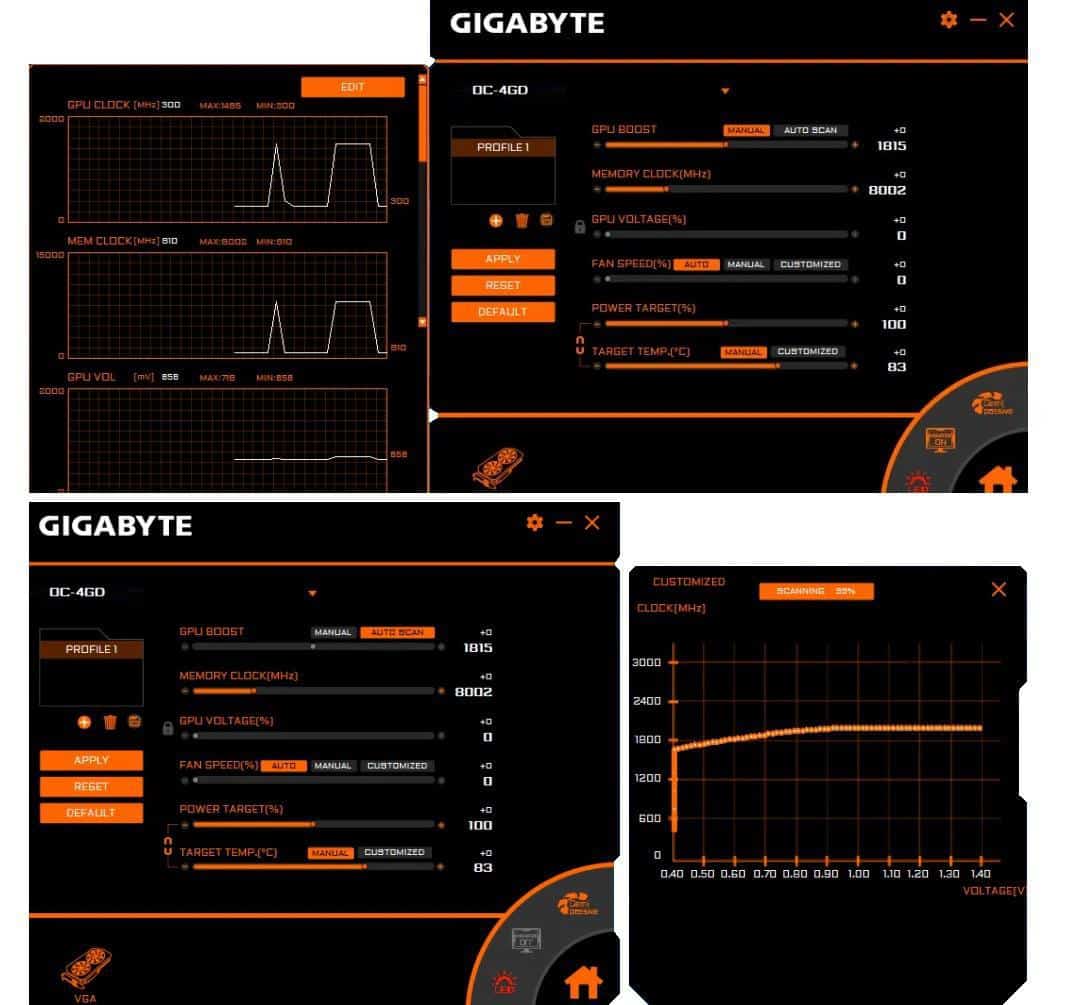
NVIDIA GeForce GTX 1650 AORUS
Another great feature AORUS has is AUTO SCAN.
For those into RGB, the GTX 1650 OC 4G has included the RGB Fusion 2.0 software into the AORUS engine, letting users control the RGB lighting effects on the video card. The software lets you adjust colors, effects, speed and brightness.
Now let’s head over to benchmark tests, where we see how the GeForce GTX 1650 OC 4G fares against other GPUs.
Gigabyte GeForce GTX 1650 Gaming OC: Testing
We will be testing the GeForce GTX 1650 OC 4G against GeForce GTX 1060, but also the AMD Radeon RADEON RX 570. We will also add the results from GeForce GTX 1660 and 1660 in our tests.
Our benchmark tests will include games such as Grand Theft Auto V, Battlefield V, Ashes of the Singularity: Escalation, Destiny 2, and The Witcher 3 and more.
Our main focus here is to test the GeForce GTX 1650 OC 4G and see how it handles popular games at 1080p resolution at high or very high settings. We will take a closer look at how the GTX 1650 stands against the GTX 1660 and see which one is a better purchase. Note that the GTX 1660 is around $50 more expensive than the GeForce GTX 1650 and the AMD Radeon RADEON RX 570 is around $30 more expensive as well.
We’re choosing the 1080p resolution setting because let’s face it, the GeForce GTX 1650 OC 4G is a 1080p-oriented video card, and running higher resolutions just didn’t make sense anymore.
One essential detail is not only how well the GeForce GTX 1650 performs, but how it handles max settings while not draining too much power and, of course, not breaking the bank. Price per performance is very important, and we’ll touch this subject by the end of our review. Let’s see how the GeForce GTX 1650 OC performs in our tests.
Battlefield V
Battlefield V is a first-person shooter video game developed by EA DICE and published by Electronic Arts, on November 20, 2018.
The average FPS for Battlefield V shows that the GeForce GTX 1650 OC 4G is lagging behind the RADEON RX 570 and all other video cards. Nonetheless, at an average of 62.1 FPS at ultra settings is more than reasonable for this budget-friendly GPU. Meanwhile, the slightly more expensive RADEON RX 570 has an average of 75.5 FPS in Battlefield V, at ultra settings. As prices jump, we see that the performance gets better, as it should. The GeForce GTX 1660 has 30 more FPS in this test than the GeForce GTX 1650.
Ashes of the Singularity
Ashes of the Singularity is a real-time strategy video game developed by Oxide Games and Stardock Entertainment, and released on March 31, 2016. On November 2016, Ashes of the Singularity: Escalation was released as a standalone expansion pack.
The average FPS for Ashes of the Singularity: Escalation showed us that the GeForce GTX 1650 OC 4G was way down at the bottom with an average of 28.1 FPS. We did spot some visible stuttering, but it was acceptable enough.
Meanwhile, the RADEON RX 570 was slightly a better performer at crazy high settings, scoring and average of 31.6 FPS – only 3 FPS better than the GTX 1650. When looking at the GTX 1660, we see a much better performance, with an average of 43.1 FPS.
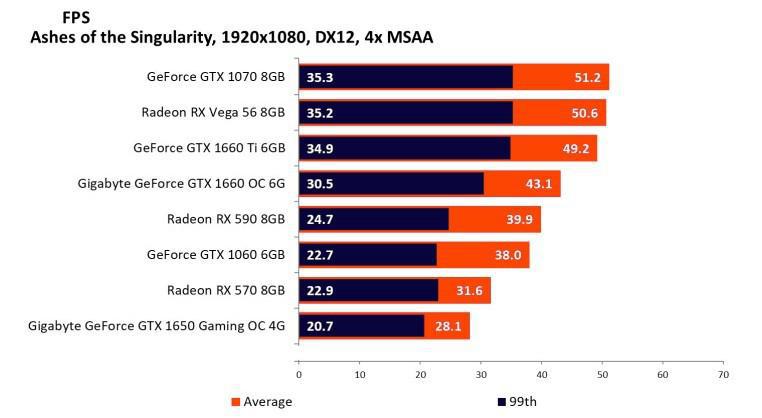
Destiny 2
Destiny 2 is a free-to-play online-only multiplayer first-person shooter video game developed by Bungie, and released on September 6, 2017 on consoles (and a month later on PC).
In our Destiny 2 benchmark tests, the GeForce GTX 1650 yielded the best results at high settings, having around 69 FPS on average. However, it still was a bit behind the RADEON RX 570 – with 2FPS! As expected the GTX 1660 was once again above the GTX 1650 by 30 FPS.
Grand Theft Auto V
Grand Theft Auto V is an action-adventure game developed by Rockstar North and published by Rockstar Games, released on 17 September 2013.
When running Grand Theft Auto V, the GeForce GeForce GTX 1650 only pulled off an average of 53.7 FPS, but this is the first time we see it above the RADEON RX 570, which is quite surprising. The GeForce GTX 1660 still has a much better result, with an average of 75 FPS.
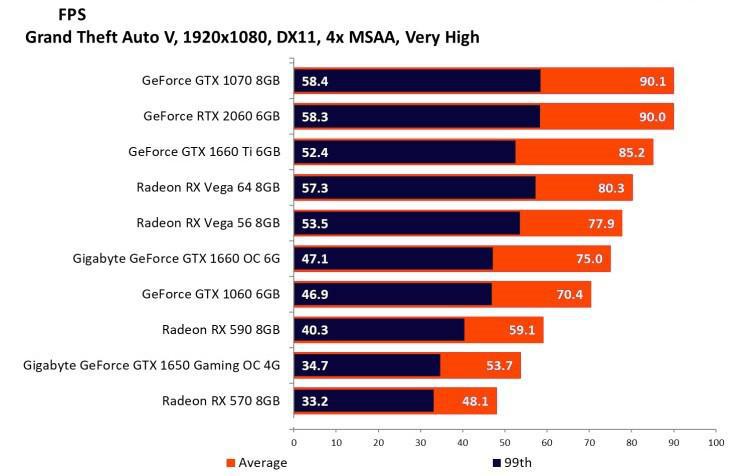
The Witcher 3
The Witcher 3: Wild Hunt is an action role-playing game developed and published by Polish developer CD Projekt, and released on 19 May 2015 on PC, PS4 and Xbox One.
While the GeForce GTX 1650 only has an average of 60 FPS in The Witcher 3 at ultra settings, it only got dethroned by the RADEON RX 570 with a difference of only 3.7 FPS, which is once again proof that the GeForce GTX 1650 is as good as AMD’s video card.
Forza Horizon 4
Forza Horizon 4 is a racing video game developed by Playground Games and published by Microsoft Studios, released on 2 October 2018.
Once again, at ultra, the GeForce GTX 1650 did well, scoring an average of 63.4 FPS. The competition did well too, with 73.6 FPS. Meanwhile, as most results have shown so far, the GeForce GTX 1660 is 30 FPS above the GeForce GTX 1650.
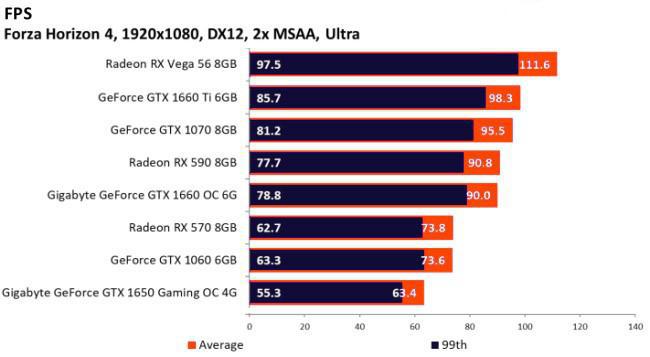
Far Cry 5
Far Cry 5 is a first-person shooter game developed by Ubisoft Montreal and Ubisoft Toronto and published by Ubisoft, released on March 27, 2018.
With HD textures on and at ultra settings, the GeForce GTX 1650 was able to pull off an average of 57.3 FPS, lagging behind the RADEON RX 570 at only 5 FPS distance. The gap between the GeForce GTX 1660 and the GTX 1650 got smaller, with the former having an average of 81.3 FPS.

Shadow of the Tomb Raider
Shadow of the Tomb Raider is an action-adventure video game developed by Eidos Montréal and published by Square Enix, released on 14 September 2018 on PC, PS4 and Xbox One.
We ran Shadow of the Tomb Rider at high and saw the GeForce GTX 1650 struggle to get an average of 44.9 FPS. Close to it, the RADEON RX 570 was able to get 52.3 FPS. Meanwhile, the GTX 1660 pulled off 68.14 FPS on average.
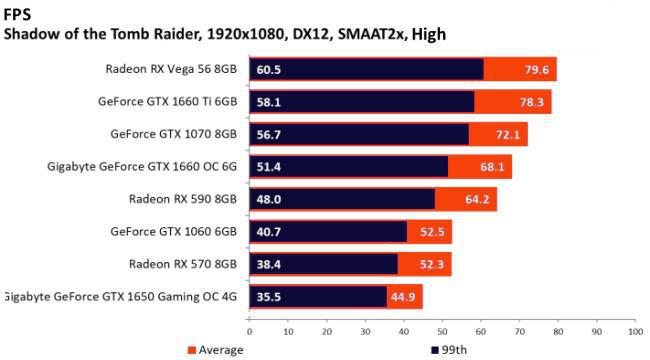
Tom Clancy’s the Division 2
Tom Clancy’s The Division 2 is an online action role-playing video game developed by Massive Entertainment and published by Ubisoft, released on March 15, 2019.
The ultra setting in Tom Clancy’s the Division has shown us the GeForce GTX 1650 was still able to work at 43.5 FPS. At only 8 FPS distance, the RADEON RX 570 was still above the GeForce GTX 1650. As for the GTX 1660, we see it pulled off 68.1 FPS.
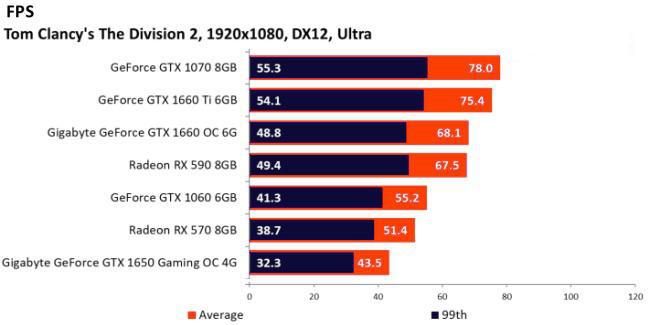
Wolfenstein II: The New Colossus
Wolfenstein II: The New Colossus is an action-adventure first-person shooter video game developed by MachineGames and published by Bethesda Softworks, released on 27 October 2017 on PC, PS4 and Xbox One.
The last game we tested the three GPUs is Wolfenstein II: The New Colossus. At Uber settings, the equivalent of ultra, we see the GeForce GTX 1650 pulled an average of 46.1 FPS. What is really interesting is that the competitor RADEON RX 570 had an average of 87.3 FPS, almost twice as the GeForce GTX 1650! The GTX 1660 once again rose above all and had an average of 113.6 FPS.
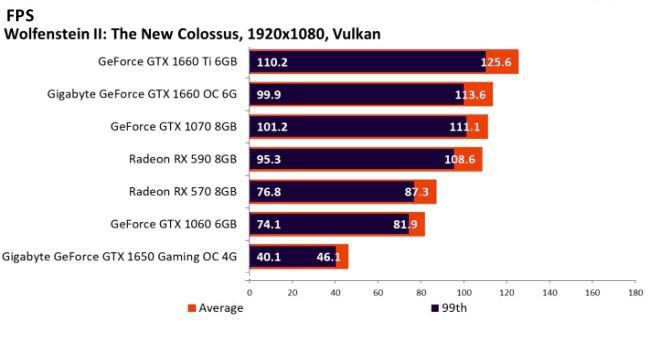
As you can see, the GeForce GTX 1650 can play most AAA games from 2013 up to 2019 at high and ultra high settings, with an average of 40-70 FPS in most games – except for the average of 28 FPS in Ashes of Singularity. It is not bad for a low-end GPU, but there are some caveats.
There’s no doubt about the GeForce GTX 1650 being much better than the GeForce GTX 1050 and the GTX 1050 Ti, which is why we haven’t added in our list. For those willing to know at least one result from the two older video cards, for instance, at crazy high settings, the average FPS for Ashes of the Singularity for the GTX 1050 Ti was 21.8. Compared to the 28.1 the GeForce GTX 1650 pulled off, it wasn’t that bad. However, if there’s one thing you shouldn’t do is choose an older GPU than one that has already been on the market for a year. Note that the GeForce GTX 1050 Ti got released in 2016, whereas the GeForce GTX 1650 was released in 2019.
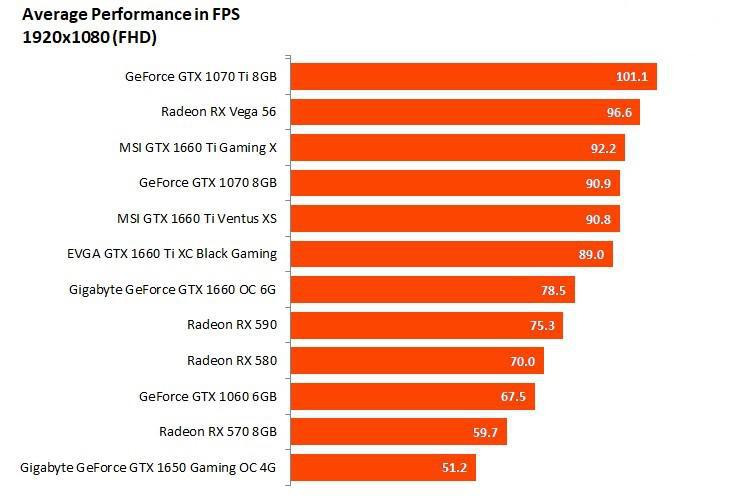
NVIDIA GeForce GTX 1650 TEST RESULTS
User Benchmark Tests
When looking at User Benchmark tests, we also see a glimpse of how big of a difference we have between the GeForce GTX 1650 and the AMD RADEON RX 570, and between the GeForce GTX 1650 and the GeForce GTX 1660.
In these test results, we will also talk about Effective FPS (EFps). Effective FPS uses both average Fps and frame drops, so it’s a good tool when it comes to measuring gaming experience.
NVidia GeForce GTX 1650 vs. AMD RADEON RX 570
GeForce GTX 1650 has reasonable Effective FPS (EFps), even pulling off 13% more than the RADEON RX 570 when running Frotnite at 1080p and maximum settings.
However, it disappoints when testing other games, with a 24% gap when it comes to CSGO (1080p, max.) In total, the EFps of the GeForce GTX 1650 is 11% lower than what the AMD RADEON RX 570 can offer.
The GeForce GTX 1650 doesn’t shine in the FPS results when it comes to the average lighting, MRender and Gravity – that are 19% lower, or to overclocked score, which is only 9% lower than the scores pulled of by the AMD RADEON RX 570.
NVidia GeForce GTX 1650 vs. NVidia GeForce GTX 1660
It was obvious the GTX 1660 would outperform the GTX 1650, but what surprised us was the CSGO EFps which was only 18% bigger than the one scored by the GTX 1650. When it comes to the average FPS score in lighting, MRender and Gravity, there’s a 55% increase, and the overclocked score is 43% more than the one the GTX 1650 was able to yield.
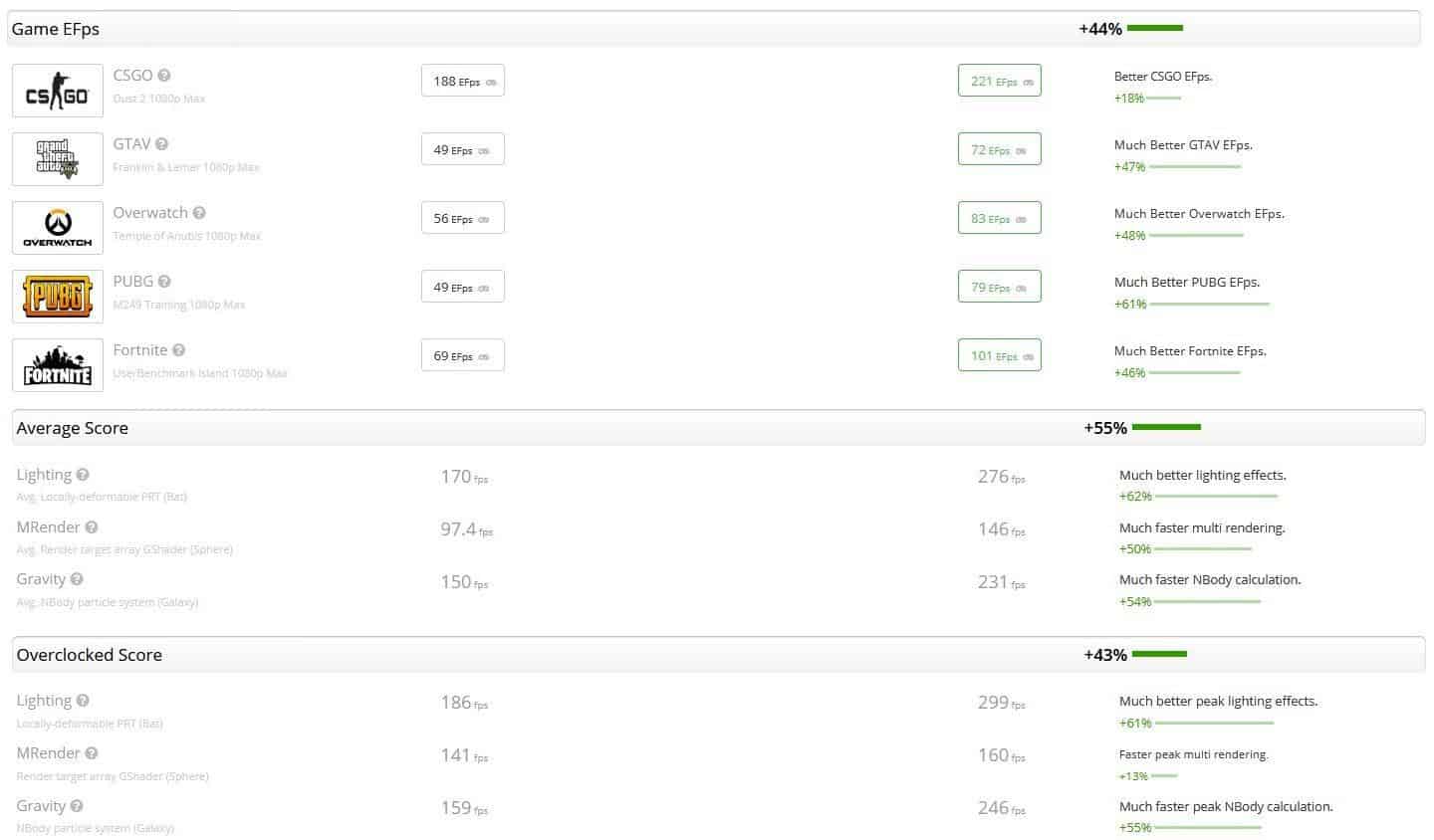
In conclusion, the UserBenchmark tests once again reveal the obvious: the GTX 1650 offers what it was actually built to offer: average performance at low power consumption. However, although the video card is aimed at gamers on a budget, you will soon see why the GTX 1650 is not the best GPU in terms of price per performance ratio.
Let’s see how the GeForce GTX 1650 fares in terms of temperature and power consumption.
Gigabyte GeForce GTX 1650 Gaming OC: Temperature and Power Consumption
The GeForce GTX 1650 uses the PCIe slot and a six-pin PCIe connector to get its power. When idle, the power consumption is very low, thanks to the TU117 processor and the semi-passive fan from Gigabyte.
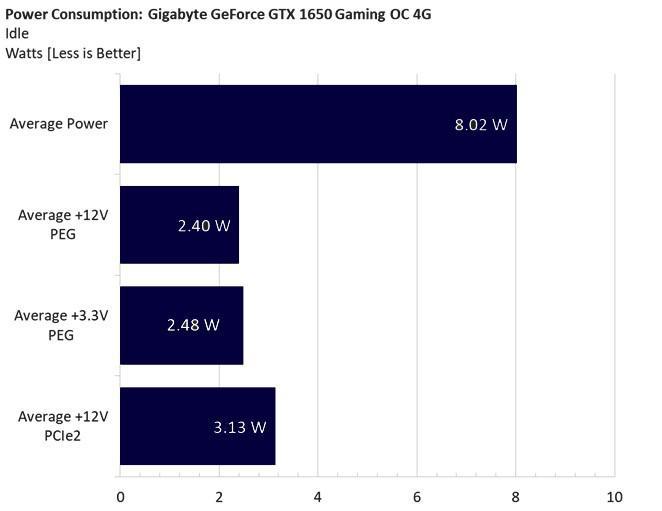
When you start gaming, at very high settings, the GeForce GTX 1650 needs 77.19 W on average to run Metro: Last Light, for instance. It is not a huge spike, but it is a bit higher than NVidia has mentioned in its technical specifications.
The multiple test results show a consistent power consumption, meaning that the video card is not limited by power or temperatures.
While the GeForce GTX 1650 is not as powerful in terms of performance as the GTX 1660, it is power efficient. In the same tests, the GTX 1660 ate an average of 120-130 W, compared to the less than 80 W the GeForce GTX 1650 needed.
In terms of temperature, the GeForce GTX 1650 once again had much better results compared to the GeForce GTX 1660. The fan speed (less is better) when running Metro: Last Light at very high settings was well under 1,800 RPM, while the GeForce GTX 1660 reached the 2,000 mark.
With all of these tests and results, what is our verdict? Let us see the final thoughts and conclusion on the last page of our Gigabyte GeForce GTX 1650 Review.
Gigabyte GeForce GTX 1650 Gaming OC: Final Thoughts & Conclusion
NVidia’s Turing and technological dominance is still prominent. However, even though the low-end video card comes at a low price, it faces a lot of competition.
Of course, for those that have an OEM gaming system or an older one, the GeForce GTX 1650 from Gigabyte will do just fine.
In terms of consistent execution, the GeForce GTX 1650 did an excellent job, and while the performance was not exactly great in our test, it is good to see that the low-end GPU got the TU117 architecture that had been used in RTX GPUs. Compared to its predecessor, the GTX 1050 Ti, the GeForce GTX 1650 is around 30% faster, but users will notice a bigger bum in performance if they are replacing an older GPU, like a GTX 750, GTX 950 and so on. For instance, GeForce GTX 1650 is 63% faster than the GTX 950, and 111% faster than the GTX 750 Ti.
One pro the GeForce GTX 1650 comes with is the sub-75W consumption, which makes it a great candidate in this category.
Aside from the huge difference, we saw at Wolfenstein II: The New Colossus, the GTX 1650 caught up with the RADEON RX 570, even yielding a better score at Grand Theft Auto V. Although the differences between them has been very small in nearly all tests, it was clear that the GTX 1650 was not as good as AMD’s video card. One extra the RX 570 has is the 8GB trim and at around the same price as the GTX 1650, which only comes in 4GB trim.
Nonetheless, the GTX 1660 was above the two GPUs, almost always pulling off 30 more FPS over the two video cards. The GTX 1660 is around 50$ more expensive than the other two. With far better performance, the GeForce GTX 1660 is a much better choice for an upgrade.
One big hurdle the GTX 1650 still faces today and makes buyers consider other options is the fact that NVidia has not lowered the prices for this video card as time passed. AMD is willing to cut the prices, and we are looking at the aforementioned RADEON RX 570, which is a mid-range card at under $150. The RADEON RX 570 brings to the table more performance, more memory, more bandwidth and a lot more bundled games. The only thing where NVidia would win is the architectural efficiency in terms of power consumption.
So what is the bottom line?
The GeForce GTX 1650 is a low-end video card that needs only 75W to power up games like Metro: Last Light at very high settings. That is its biggest selling point.
If you are all about performance per price, then do not expect to see that in NVidia’s GPU. You will get the technological superiority, but forget about the bang for the buck. Looking at the image below, we see how low the GTX 1650 positions itself in this category, and it is once again clear that the newer GTX 1660 is a much better choice, even if it’s $50 more expensive.

While it is not the all-around winner, the GTX 1650 is a good budget GPU that needs low power, makes little noise and needs an x16 PCIe slot. It is not bad in terms of performance, since it can reach and surpass 60 FPS at 1080 in medium settings, and hits 60 FPS in most 1080 games at high and ultra settings.
Nonetheless, if you are looking to build a cheap gaming PC, the GeForce GTX 1650 does not make sense anymore since better GPUs at nearly the same prices are already on the market. We have mentioned the GTX 1660, for instance. If you are looking to get a compact PC in your living room, and use it for light to moderate gaming, the GTX 1650 is good enough. However, if you have updated your video card in the past 3-4 years, you probably do not need it and you should either choose the GTX 1660 or wait for a new budget-friendly GPU this year. That is the only way you will notice a true boost in performance.

